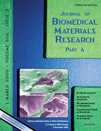Fabrication of low-crystallinity hydroxyapatite foam based on the setting reaction of α-tricalcium phosphate foam
Abstract
Low-crystallinity hydroxyapatite (HAP) foam is an ideal material for bone substitutes and scaffolds for bone tissue regeneration, because its interconnected pores provide the space for cell growth and tissue penetration, and its composition induces excellent tissue response and good osteoconductivity. In this study, the feasibility of low-crystallinity HAP foam fabrication was evaluated based on the phase transformation reaction or the so-called dissolution-reprecipitation reaction of α-tricalcium phosphate (α-TCP) foam granules. When α-TCP foam granules were placed in water at 37°C for 1 day, no reaction was observed. However, α-TCP foam granules set to form low-crystallinity HAP by treating it hydrothermally at 200°C. The network of fully interconnected pores was retained, and porosity was as high as 82%. Pore size ranged from 50 to 300 μm with an average pore size of 160 μm. Compressive strength was 207 kPa. Although no setting reaction was observed at 37°C, the setting reaction caused by the hydrothermal treatment of α-TCP foam granules allowed the fabrication of any shape of low-crystallinity HAP. Therefore, this method may be useful for the fabrication of bone substitutes and scaffolds in bone tissue regeneration. © 2008 Wiley Periodicals, Inc. J Biomed Mater Res, 2009




